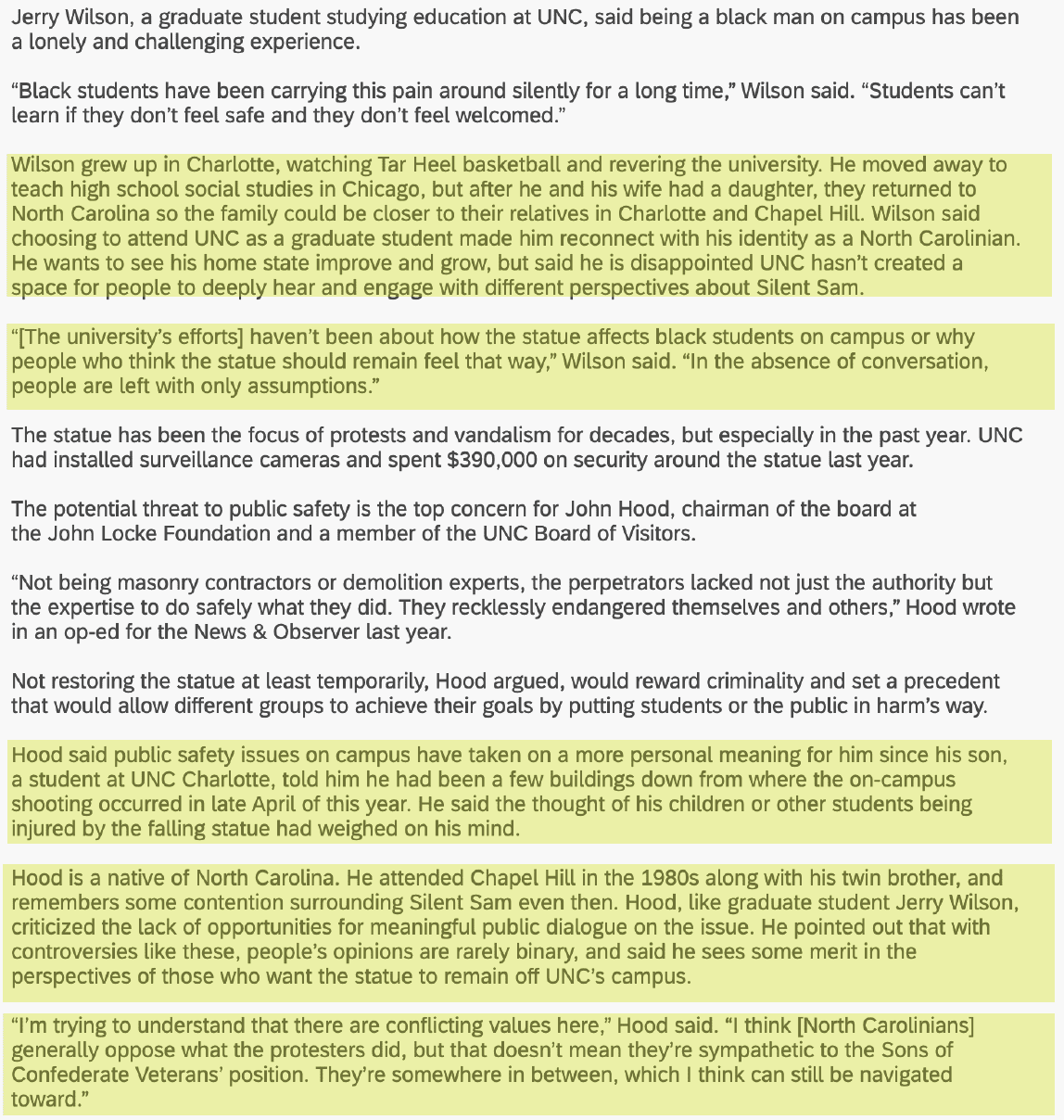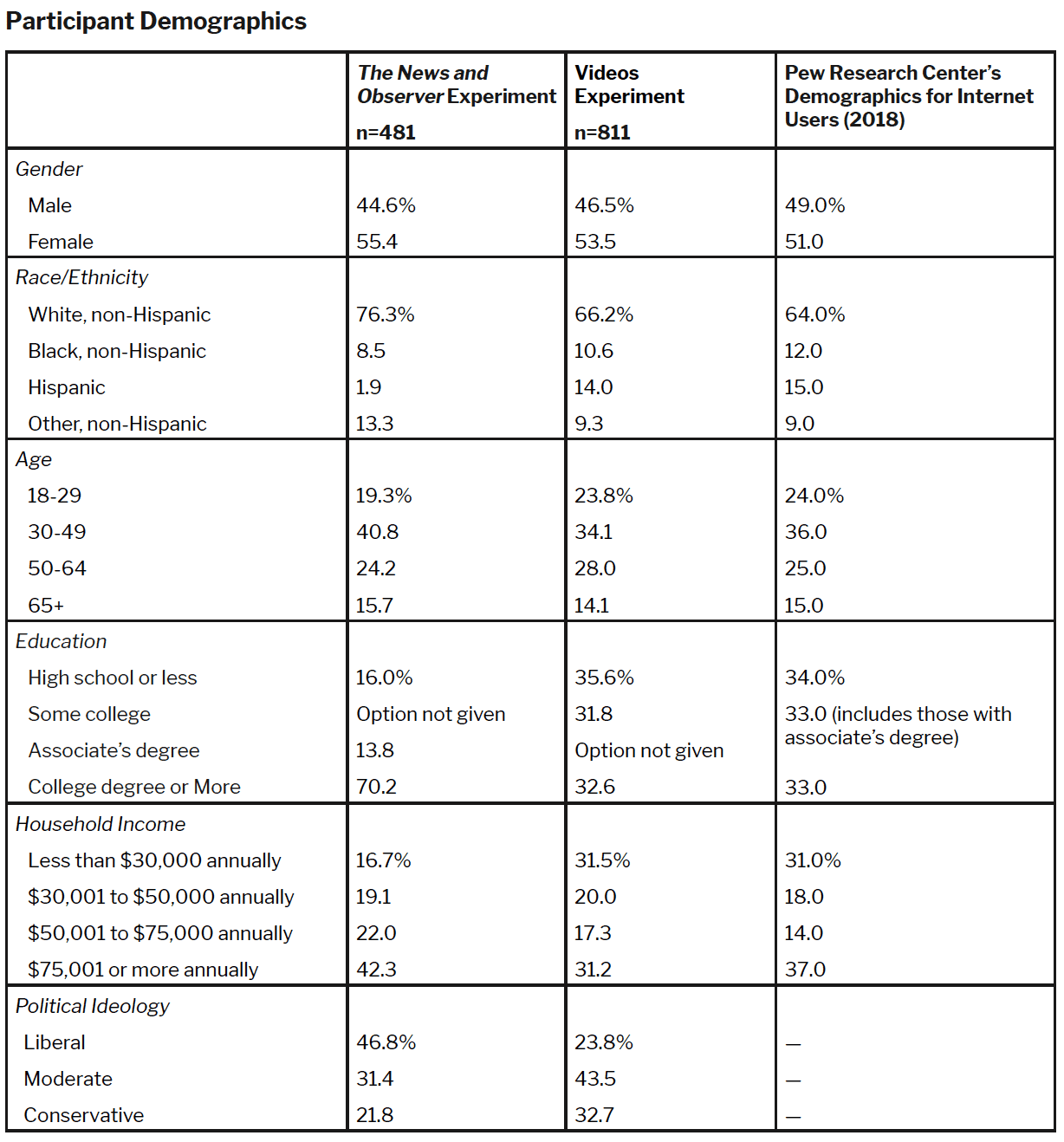
News organizations must take great care in covering contentious political issues. The Center for Media Engagement wanted to know whether adding humanizing details about people when reporting on controversial political issues could help bring readers together across lines of difference and improve attitudes toward news organizations.
In two separate experiments, we tested two kinds of humanizing details:
- Videos of people sharing personal stories behind their opinion on an issue
- Including personal information, such as connections to the community, when describing quoted sources
The presence of these humanizing details in news articles produced mixed results. The videos increased participants’ likelihood to engage with the news organization in the future, but only when participants were specifically asked to watch the video. They also increased conservatives’ favorability toward people with opposing views, but did not affect liberals’ attitudes. Adding humanizing details about sources to news articles covering controversial topics did not affect readers’ perceptions of people with opposing views or the news organization’s credibility.
The Problem
In a time of a strongly polarized American public, news organizations have the opportunity to encourage respect and understanding instead of deepening divides. In this report, the Center for Media Engagement examines whether adding humanizing details to coverage of controversial issues influences how readers view people with opposing views and the news outlets that include these details.
We tested two kinds of humanizing details:
- Videos of people sharing personal stories behind their opinion on an issue
- Including personal information, such as connections to the community, relationships with family, and consideration of other points of view, when describing quoted sources
Key Findings
- Adding humanizing details about sources to news articles covering controversial topics did not affect readers’ perceptions of people with opposing views or the news organization’s credibility.
- Watching videos of people sharing personal stories related to a political issue increased conservatives’ favorability toward people with opposing views. However, exposure to the videos did not affect liberals’ attitudes.
- The videos increased participants’ likelihood to engage with the news organization in the future, but only when participants were specifically asked to watch the videos.
Implications for Newsrooms
Incorporating videos with personal stories or adding humanizing details to descriptions of sources do not consistently affect people’s perceptions of those with different political views. There are many ways to build understanding, however, and these results signal the need for further research on the most effective ways for newsrooms to help bridge divides.
Neither the videos nor the humanizing details about sources affected readers’ feelings about the credibility or trustworthiness of the organization. The videos did increase participants’ likelihood to engage with the news organization in the future, but only when they were asked to watch the videos.
The Experiment
The Center for Media Engagement designed two separate experiments to test the impact of including different kinds of humanizing information in news coverage of controversial issues. One experiment looked at the impact of adding videos of individuals sharing their personal narratives related to the article issue.1 The other examined the impact of adding personal details, such as connections to the community, family, etc., to descriptions of quoted sources expressing a view on a controversial topic. These studies were funded by the News Integrity Initiative at the Newmark J School, the William and Flora Hewlett Foundation, and Democracy Fund.
In the experiment with videos, participants saw either:
- An article without videos
- An article with two videos from people with opposing perspectives embedded in the text of the article
- An article without videos and a separate page after the article that included the two videos with a request to watch them
Participants were randomly assigned to read an article about one of three topics: marijuana legalization, immigration, or gun control.
For the experiment that tested the impact of humanizing details about quoted sources, the Center for Media Engagement worked with The News & Observer, a McClatchy-owned newspaper based in Raleigh, North Carolina. Journalists from The News & Observer and researchers worked together to create a new version of a previously-published news article about a controversial issue in the community – the removal of a Confederate statue called Silent Sam from the University of North Carolina’s campus. One version included additional personal details about the quoted sources in the article and one did not include this information.2 The quoted sources held differing views on removing Silent Sam from campus.
Attitudes toward those with opposing views
We wanted to know if the presence of humanizing information in a news article about a controversial topic could help bring people together across lines of difference. In both experiments, participants were asked to rate how favorably they felt toward those who held the opposite view than them on the political issue they read about on a scale of 0 (very unfavorable) to 10 (very favorable).
Adding personal details about quoted sources’ lives and ties to the community in the text of an article did not significantly affect the favorability ratings.3 Participants who read an article without humanizing details rated those holding opposing views 2.87 on average. With humanizing details added to the descriptions of quoted sources, the average was 2.79.
Similarly, the presence of the videos of people who shared personal stories did not significantly affect the favorability ratings.4 On average, those who viewed an article with no videos rated those holding opposing views at 3.71. Those viewing an article with the videos rated those holding opposing views at 3.60 and those asked to watch the videos as part of the study rated those with opposing views at 4.12.
There was some evidence that ideology played a part in whether the videos influenced readers’ opinions of people with opposing views. Participants who identified as conservative rated those who disagreed with them significantly higher on the favorability scale, but only when they were specifically asked to watch the videos as part of the study.
Liberals also appeared to react to the three possible article topics differently.5 When assigned to view the article about immigration, liberals rated those who disagreed with them on the issue less favorably than when they viewed the article about marijuana legalization or gun control.
Participants in both experiments were also asked how well a series of nine adjectives, such as intelligent and hypocritical, applied to people on the opposite side of their position.6 The ratings were averaged, and ranged from 1 to 5, with higher values indicating more positive reactions.
The presence of humanizing details about quoted sources did not affect how positively participants rated people who disagreed with them.7 The average rating from participants who read an article without personal details was 2.42. Participants who read an article with personal details about quoted sources gave an average rating of 2.39.
Videos of people sharing their personal stories also did not affect the ratings.8 The average ratings were 2.71 for those who viewed an article with no videos, 2.67 for those who viewed an article with the videos present, and 2.72 for those who were asked to watch the videos. The same interaction between article topic and ideology found in the favorability ratings also emerged here – liberals rated those who disagreed with them less positively when they viewed the article about immigration than when they viewed the article about gun control or marijuana legalization.9
Attitudes toward news organizations
We also evaluated whether adding humanizing details to an article about a controversial issue could affect readers’ attitudes toward a news organization. For the experiment with personal details about quoted sources, the news organization was The News & Observer, a local newspaper in North Carolina. For the experiment with videos, we used a mock news organization.
In the study focused on adding personal details about quoted sources, readers were asked to evaluate six statements related to the credibility of The News & Observer from 1 (strongly disagree) to 7 (strongly agree).10 The presence of more personal information about quoted sources did not affect how credible or trustworthy people thought The News & Observer was.11 The average rating for the article without personal details was 4.74 and the average rating for the article with personal details was 4.60.
Participants in the experiment with videos were asked to rate how well a series of positive terms applied to the mock news site.12 There were no significant differences in people’s attitudes toward the mock news outlet depending on if they viewed an article with no videos, an article with videos, or an article with videos and a specific request to watch the videos.13
Participants in both experiments were also asked how likely they were to take certain actions related to engaging with the news organization, such as sharing the article or reading more about the issue from 1 (very unlikely) to 7 (very likely).14
The videos increased participants’ likelihood to engage more with the news organization in the future, but only when participants were specifically asked to watch the videos.15 The average responses were 3.78 for those who saw an article with no videos, 3.85 for those who saw an article with videos, and 4.19 for those who saw an article and were asked to watch the videos.16
Whether participants read an article with or without personal details about quoted sources did not influence how likely they were to take engagement-related actions in the future.17
Other areas of testing
As a part of the experiment with The News & Observer, we also investigated whether including inflammatory language in an article about a controversial issue affected perceptions. We found that participants who opposed the removal of Confederate statues on campus and who read an article with inflammatory language reported a lower likelihood to subscribe to The News & Observer compared to those who opposed removal and read an article without this language.18 In other words, inflammatory language can reduce intentions to subscribe at least for some groups.
The presence or absence of inflammatory language did not influence perceptions of people with opposing views or ratings of The News & Observer’s credibility overall.
Methodology
For the experiment focused on videos of personal stories, 811 participants were recruited from Dynata (Research Now/SSI) between June 25, 2018 and July 19, 2018.19 We tested for demographic differences across the conditions and found a significant difference in average yearly income across conditions. To account for this, all analyses from the video experiment mentioned in this report controlled for reported yearly income.
Participants in the videos study viewed an article about one of three topics: gun control, immigration, or marijuana legalization. The articles were real news articles (taken from National Public Radio and Time) and were edited for length. The topics were chosen because of their ongoing and contentious nature.
A total of six videos were used in the experiment. All of the videos were approximately one to two minutes long. The stories were delivered by either an Asian-American female actress (called “Ann”) or a white male actor (called “Jeff”). One video about marijuana legalization featured “Ann” sharing how her father’s use of medical marijuana soothed his chronic pain and improved his quality of life. The other video about marijuana legalization featured “Jeff” talking about a time in his life when he was addicted to marijuana and the negative impact it had on his productivity. One of the videos about guns featured “Ann” describing how her experience being robbed at gunpoint created her strong distaste for guns. The other video about guns featured “Jeff” talking about a time when carrying his licensed handgun saved him and his wife from being robbed. One video about immigration featured “Ann” sharing her frustration with illegal immigration, as her family was waiting in their home country to obtain U.S. residency legally. The other video about immigration featured “Jeff” talking about a friend of his who uprooted her life when her husband was deported.
For the study on personal details about sources, 225 people were recruited from call-outs on The News & Observer’s website and social media accounts. These participants took the survey between July 10, 2019 and September 12, 2019. To supplement the sample size, 256 participants located in North Carolina were recruited using TurkPrime, an online platform that draws participants from Amazon’s Mechanical Turk, between October 9, 2019 and November 19, 2019, bringing the total number of participants to 481.20 We controlled for the different recruitment styles throughout the analysis. We also tested for differences in demographic factors across the conditions and found no differences.
Pictured below is an excerpt of the article with humanizing details used in The News & Observer experiment. The humanizing details added to the descriptions of the two quoted sources are highlighted in yellow. In the version of the article without humanizing details, the highlighted sections were removed.
Both experiments were embedded in Qualtrics-based online surveys. In each study, participants gave informed consent and then viewed the news article (with or without humanizing details for The News & Observer study; without videos, with videos, or without videos and a request to view them in the video narratives study). Study participants then answered the questions as detailed in this report.
Given that many of the results were not statistically significant, it is important to examine whether our sample size allowed us to detect effects. Analysis confirms that these studies are able to detect medium and large effects, but may miss small effects.21
See below for a table that details the demographics of the participants from the two experiments.
SUGGESTED CITATION:
Stroud, Natalie Jomini, Murray, Caroline, and Curry, Alex. (2020, August). Adding humanizing details to news articles produces mixed results. Center for Media Engagement. https://mediaengagement. org/research/humanizing-details
- All six videos featured true stories gathered from a survey on Amazon’s Mechanical Turk. The stories were delivered by actors. [↩]
- Both versions used in the survey were shortened from the article originally published in The News & Observer. The only difference between the two versions used in the survey was the presence of humanizing details about the quoted sources in one version. All of the information presented in the articles was factual and based on The News & Observer’s reporting and/or later interviews by researchers with quoted sources. [↩]
- We tested for differences using ANOVA. There was no significant effect of condition F(2, 454) = 0.058, p > .05. [↩]
- We tested for differences using ANOVA. There was no significant effect of condition F(2, 778) = 0.240, p > .05. [↩]
- We tested for differences using ANOVA. There was a significant interaction between article topic and political ideology F(4, 778) = 2.56, p < .05. [↩]
- Adjectives included patriotic, intelligent, honest, open-minded, generous, close-minded, hypocritical, selfish, and mean. In each experiment, ratings of each adjective were combined into a single variable (Cronbach’s alpha for videos: 0.868, Cronbach’s alpha for personal details about quoted sources: 0.881). [↩]
- We tested for differences using ANOVA. There was no significant effect of condition F(2, 463) = .190, p > .05. [↩]
- We tested for differences using ANOVA. There was no significant effect of condition F(2, 762) = .229, p > .05. [↩]
- We tested for differences using ANOVA. There was a significant interaction between article topic and political ideology F(4, 762) = 4.70, p < .05. [↩]
- Statements included “is concerned with my interests,” “is focused on helping people like me,” “cares about getting the facts right,” “is fair in its reporting,” “knows the community well,” and “provides all the information I need to fully understand its news.” Responses were combined into one variable to test for differences (Cronbach’s alpha: 0.932). [↩]
- We tested for differences using ANOVA. There was no significant effect of condition F(2, 451) = 0.499, p > .05. [↩]
- The list of terms included enjoyable, interesting, informative, credible, accurate, not biased, fair, can be trusted, and tells the whole story. Responses were combined into one variable to test for differences (Cronbach’s alpha: 0.875). [↩]
- We tested for differences using ANOVA. There was no significant effect of condition F(2, 748) = 1.98, p > .05. [↩]
- In the video experiment, participants rated four activities: sharing the article on social media, reading more articles by the author, reading more articles from the website, and talking to people about the article. They were combined into a single variable to test for differences (Cronbach’s alpha: 0.917). In The News & Observer experiment, participants rated five activities: reading more articles about the issue, “liking” the article on Facebook, talking with others about the issue, sharing the article on social media, and subscribing to The News & Observer. They were combined into a single variable to test for differences (Cronbach’s alpha: 0.841). [↩]
- We tested for differences using ANOVA. There was a significant effect of condition F(2, 803) = 4.20, p < .05. The average responses were 3.78 for those who saw an article with no videos, 3.85 for those who saw an article with videos, and 4.19 for those who saw an article with videos and were also asked to watch them. [↩]
- There were no differences in intentions to engage between those who viewed a story without videos and those who saw a story with videos embedded in the article, but who were not specifically asked to watch them. There were also no significant differences between those who were specifically asked to watch the videos and those who saw a story with videos embedded in the article. [↩]
- We tested for differences using ANOVA. There was no significant effect of condition F(2, 451) = 1.30, p > .05. [↩]
- We tested for differences using ANOVA. There was a significant effect of condition F(2, 449) = 4.19, p < .05. [↩]
- 136 people who started the survey were excluded from the analysis, either because they 1. Were not able to view the videos, 2. Did not finish the survey or attempted to take the survey multiple times, 3. Failed to correctly identify the article topic, or 4. Rushed through or gave blanket answers to survey measures. [↩]
- 105 people who started the survey were excluded from the analysis, either because they 1. Were not located in North Carolina, 2. Did not finish the survey or attempted to take the survey multiple times, 3. Failed to correctly identify the topic of the article, or 4. Rushed through or gave blanket answers to survey measures. [↩]
- Calculations based on alpha of 0.05, power of 0.80. For the personal details for quoted sources study (n=481), the effect size f is 0.14. For the videos study (n=811), the effect size f is 0.11. The standards for effect size are f of 0.40 is a large effect, 0.25 for a medium effect, and 0.10 for a small effect. [↩]






